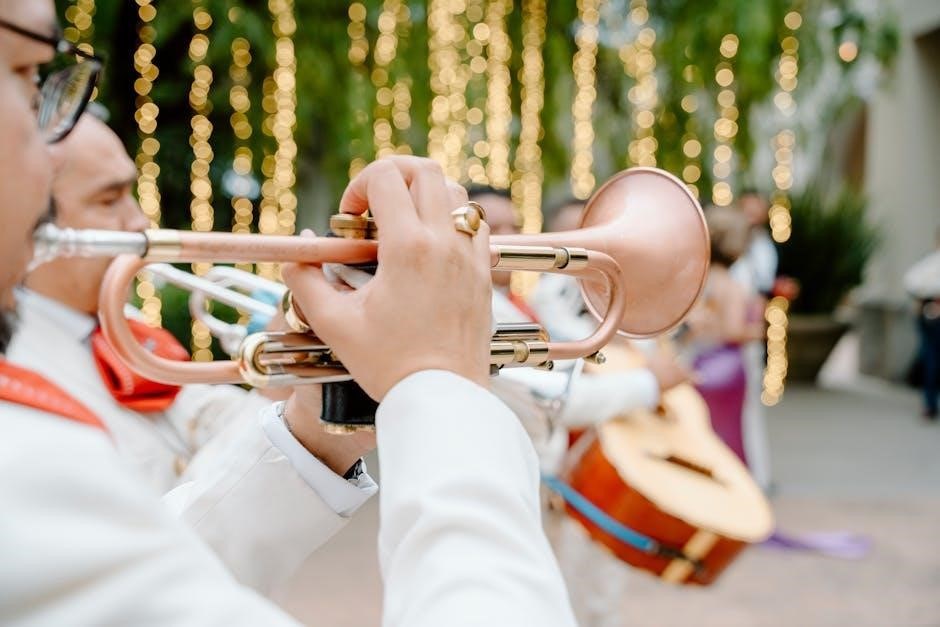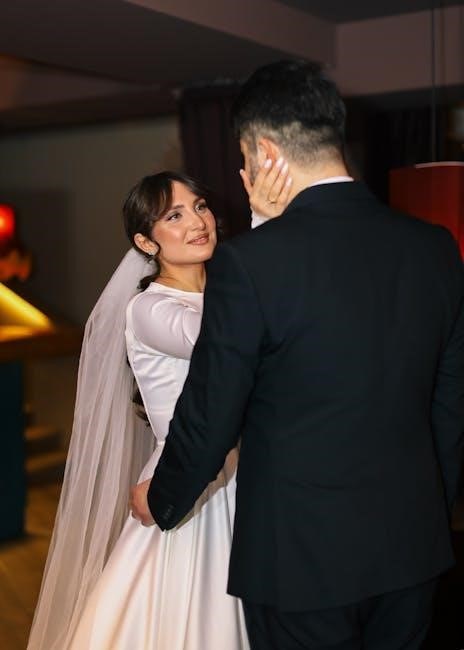Catholic wedding music is a sacred and integral part of the ceremony, reflecting divine love and unity. Traditional hymns, classical compositions, and sacred songs create a reverent atmosphere, honoring the couple’s commitment and faith.
Overview of Catholic Wedding Ceremonies
A Catholic wedding ceremony is a beautiful blend of liturgy and tradition, emphasizing the sacred union of two individuals before God. The ceremony typically includes the Processional, Liturgy of the Word, Sacrament of Matrimony, Communion, and Recessional. Music plays a vital role in setting the tone for each part of the ceremony, from the entrance of the bride to the final blessing; The nuptial Mass, also known as the wedding ceremony, is deeply rooted in faith and symbolism. The choice of music is carefully selected to reflect the couple’s commitment to God and to each other, ensuring the ceremony remains reverent and meaningful. This sacred celebration is a joyful expression of love, faith, and unity.

Importance of Music in Catholic Weddings
Music in a Catholic wedding holds profound spiritual significance, serving as a means to glorify God and celebrate the sacred union of the couple. It fosters a reverent atmosphere, unifying the congregation in prayer and joy. Catholic wedding music is not merely decorative but is deeply intertwined with the liturgy, expressing the couple’s commitment to their faith and to each other. The carefully chosen hymns and compositions reflect divine love, guiding the ceremony with elegance and devotion. By incorporating sacred music, the couple honors their faith and creates a memorable experience for all attendees. Music becomes a powerful tool for expressing emotions and beliefs, making it an essential element of the ceremony.
Traditional Catholic Wedding Music
Traditional Catholic wedding music is timeless and sacred, featuring classic compositions like Ave Maria, Bridal Prayer, and Canon in D, creating a reverent and elegant atmosphere for the ceremony.
Popular Hymns for the Ceremony
Popular hymns for a Catholic wedding ceremony include timeless pieces like Ave Maria and Bridal Prayer, which evoke devotion and unity. These sacred songs, often sung during key moments such as the processional or communion, reflect the couple’s faith and commitment. Other cherished hymns, such as O Mary of Graces and The Magnificat, add a traditional and reverent touch to the celebration. These selections are chosen for their ability to inspire spirituality and connection, aligning with the sacred nature of the ceremony. They serve as a beautiful expression of love and faith, creating a meaningful atmosphere for the couple and their guests.
Classical Compositions for the Processional
Classical compositions are a cornerstone of Catholic wedding processional music, offering elegance and timeless appeal. Pieces like Adagio Cantabile by Johann Sebastian Bach and Arioso provide a serene and dignified atmosphere. Canon in D by Johann Pachelbel is a popular choice, its gentle and joyful melody perfectly accompanying the bride’s entrance. Jesu, Joy of Man’s Desiring by Bach is another favorite, blending sophistication with spiritual depth. These classical works are often performed by orchestras or solo instruments, creating a majestic and reverent ambiance. They are well-suited for the processional, as they honor the sacred nature of the ceremony while enhancing the emotional impact of the moment. Their enduring popularity stems from their ability to balance tradition with beauty, making them ideal for this significant part of the wedding celebration.
Sacred Songs for the Recessional
Sacred songs for the recessional are chosen to celebrate the newlyweds’ union with joy and gratitude. Traditional pieces like the Wedding March by Mendelssohn are iconic, while Ode to Joy offers a jubilant tone. Sacred hymns such as O Mary of Graces and The Magnificat chant infuse the moment with spiritual reverence. These songs are often performed by choirs or instrumental ensembles, creating a triumphant and uplifting atmosphere as the couple exits the church. Their selection aligns with the liturgical guidelines, ensuring the music reflects the sacredness of the occasion. These sacred songs not only honor the couple’s commitment but also express the congregation’s blessings and joy for their future together.

Modern Catholic Wedding Music
Modern Catholic wedding music blends contemporary styles with sacred traditions, offering a fresh yet reverent sound. Instrumental and vocal pieces reflect divine love and joy in celebration.
Contemporary Hymns Approved for Use
Contemporary hymns in Catholic weddings offer a modern expression of faith while maintaining sacred traditions. Many approved hymns, like As I Kneel Before You by Kilbane and Covenant Hymn/Wherever You Go, blend heartfelt lyrics with spiritual meaning. These songs are chosen for their ability to reflect the divine love and commitment of marriage. The Church encourages hymns that align with Catholic teachings, ensuring the music enhances the liturgy. While there is no official list, guidelines help couples select appropriate pieces. These contemporary hymns create a meaningful connection for the couple and congregation, blending tradition with modern musical styles.
Instrumental Pieces for a Modern Touch

Instrumental pieces add a modern yet sacred ambiance to Catholic weddings. Popular choices include Canon in D by Pachelbel, Arioso by Bach, and Adagio Cantabile from Beethoven’s “Moonlight Sonata.” These timeless compositions are versatile and can be adapted to various instrumental ensembles. For a contemporary feel, couples may opt for piano, guitar, or string quartet arrangements of these classics. Instrumental music during the processional or offertory creates a serene and reflective atmosphere, aligning with the sacred nature of the ceremony. Many modern instrumental pieces are approved for use, as they maintain the dignity and reverence required by Catholic traditions. Consulting with the music director ensures selections are appropriate and beautifully arranged to enhance the liturgy while reflecting the couple’s personal style. This blend of tradition and modernity offers a unique soundtrack for the celebration.
Vocal Performances in Catholic Ceremonies
Vocal performances in Catholic weddings are a beautiful way to enhance the liturgy, offering a personal and emotional connection to the sacred rites. Traditional hymns like Ave Maria (Bach/Gounod or Schubert) and Bridal Prayer are popular choices, as they convey divine love and devotion. Vocal pieces are often performed during key moments, such as the processional, offertory, or communion. Sacred chants, like the Maginificat, also add a timeless and reverent touch. Modern vocal performances, such as Covenant Hymn or As I Kneel Before You, blend contemporary styles with sacred themes. The Church emphasizes that vocal music should reflect the dignity and spirituality of the ceremony, ensuring lyrics align with Catholic teachings. Vocalists, whether soloists or choirs, bring a heartfelt dimension to the celebration, making the wedding a deeply moving experience for all in attendance. Approval from the music director is essential to ensure selections are appropriate and meaningful.

The Role of the Music Director
The music director plays a crucial role in guiding music selection, ensuring it aligns with Catholic liturgical guidelines and enhancing the ceremony’s spiritual atmosphere through appropriate choices.
Consulting with the Church Music Director
Consulting with the church music director is essential to ensure the music aligns with Catholic liturgical guidelines and enhances the ceremony’s spiritual atmosphere. The director’s expertise helps couples choose appropriate hymns, classical pieces, or sacred songs that reflect their faith and love. They can suggest traditional or modern options, ensuring the music complements the Mass and maintains reverence. Couples should discuss their preferences and any specific songs they wish to include, while also being open to the director’s recommendations. This collaboration ensures a harmonious and meaningful musical experience, respecting both the couple’s vision and the church’s traditions.
Guidelines for Choosing Appropriate Music
When selecting music for a Catholic wedding, it’s crucial to align choices with the liturgical spirit and the church’s guidelines. Music should reflect the sacred nature of the ceremony, emphasizing themes of divine love, commitment, and unity. Couples are encouraged to prioritize sacred hymns and classical compositions over secular love songs, as these better convey the theological significance of marriage. The music director can offer valuable insights and ensure selections adhere to church standards. While personal preferences are considered, the primary focus should remain on the spiritual dimension of the celebration. This balanced approach ensures the ceremony is both meaningful and reverent, honoring the couple’s faith and the sacrament they are entering.

Catholic Wedding Mass Music
Catholic wedding Mass music enriches the liturgy, blending traditional hymns, sacred chants, and instrumental pieces to create a worshipful atmosphere, deepening the spiritual experience of the celebration.
Music for the Entrance and Processional
The entrance and processional are pivotal moments in a Catholic wedding, setting the ceremony’s tone. Traditional choices like Bach’s “Ave Maria” or Schubert’s “Ave Maria” are popular for their serene beauty. The “Bridal Prayer” by Copeland and “By My Side” by Porter also offer heartfelt options. For the processional, classical compositions such as Bach’s “Adagio Cantabile” or Pachelbel’s “Canon in D” are timeless favorites, creating a majestic atmosphere. Wagner’s “Bridal Chorus” is another iconic selection, though its origins in “Lohengrin” have sparked discussions about its sacred appropriateness. Sacred chants like “O Mary of Graces” or “The Magnificat” can also be incorporated, blending tradition with devotion. The music director plays a key role in ensuring selections align with liturgical guidelines while reflecting the couple’s faith and love story.
Hymns for the Liturgy of the Word
Hymns during the Liturgy of the Word are chosen to deepen the spiritual connection and reflect the sacredness of the occasion. Traditional selections like “As I Kneel Before You” by Kilbane or “The Magnificat” in chant form are often used to emphasize devotion. These hymns align with the readings, fostering a prayerful atmosphere. The text of the music should ideally reflect God’s love and the covenant between the couple, mirroring divine union. Sacred chants or traditional hymns like “O Mary of Graces” are also appropriate, blending reverence with joy. The music director ensures these selections complement the liturgical readings while maintaining a focus on faith and celebration. These hymns serve as a bridge between Scripture and the couple’s vows, enhancing the ceremony’s spiritual depth.
Instrumental Music During the Offertory
Instrumental music during the Offertory in a Catholic wedding Mass is a moment of sacred reflection, often featuring classical pieces that evoke reverence and prayerfulness. Traditional selections like Bach’s “Arioso” or “Adagio Cantabile” are commonly chosen for their serene and uplifting qualities. Pachelbel’s “Canon in D” is another popular choice, its gentle harmony creating a contemplative atmosphere. The music should align with the liturgical significance of the Offertory, emphasizing the offering of gifts and the couple’s commitment. The absence of vocals allows the congregation to focus on the sacred ritual. The music director plays a crucial role in selecting pieces that maintain the ceremony’s dignity and spiritual focus, ensuring the music complements the liturgy without overpowering it. This instrumental interlude serves as a beautiful bridge between the Liturgy of the Word and the Eucharistic celebration.
Communion Hymns and Their Significance
Communion hymns hold profound significance in a Catholic wedding Mass, as they accompany the reception of the Eucharist, symbolizing unity with God and the Church. These hymns are chosen to reflect the couple’s commitment and the congregation’s prayerful support. Traditional selections like “O Sacrament Most Holy” or “Panis Angelicus” are often used, emphasizing the sacredness of the moment. The hymns should deepen devotion and foster a sense of communion among all present. The music director ensures that the chosen pieces align with the liturgical context, avoiding secular or inappropriate themes. During Communion, the hymns serve as a spiritual bridge, uniting the couple and the assembly in prayer and gratitude, while honoring the sacrament’s divine essence.
Recessional and Postlude Music
Recessional and postlude music celebrate the newlyweds’ joy, transitioning from the sacred ceremony to the celebration. Traditional pieces like the Wedding March or Ode to Joy are popular, while modern options like Joyful, Joyful We’ve Got the Love add a contemporary touch, creating a triumphant and uplifting atmosphere.
Traditional Recessional Pieces
Traditional recessional pieces are timeless choices that exude joy and celebration. Mendelssohn’s Wedding March and Wagner’s Bridal Chorus are iconic, often played as the newlyweds exit. These classical compositions, rich in history and grandeur, create a triumphant atmosphere. Additionally, Ode to Joy by Beethoven is a popular selection, symbolizing unity and happiness. These pieces align with Catholic traditions, providing a dignified yet joyful conclusion to the ceremony. Many couples opt for these familiar melodies to honor their faith and celebrate their union, ensuring a memorable and uplifting recessional.
Modern Recessional Music Options
Modern recessional music offers couples a chance to blend tradition with personal style. Contemporary compositions, such as Make Me Your Home by Tomlin, or instrumental arrangements of modern hymns, create a joyful yet sacred exit. Many opt for orchestral or string versions of popular songs, ensuring a fresh yet reverent sound. These pieces reflect the couple’s faith while incorporating modern tastes. Instrumental guitar or piano renditions of sacred songs are also favored, providing a subtle yet meaningful conclusion. Modern music choices allow couples to express their unique journey while maintaining the dignity of the Catholic ceremony, making the recessional a memorable and heartfelt moment for all.

Secular vs. Sacred Music in Catholic Weddings
Sacred music reflects divine love and unity, while secular songs emphasize personal expression. The Church prefers sacred hymns but allows some secular pieces if they align with the ceremony’s dignity and faith.
Church Guidelines on Music Selection
The Catholic Church provides clear guidelines for wedding music, emphasizing that selections should reflect the sacred nature of the ceremony. Sacred music is preferred, as it aligns with the liturgical context and expresses the couple’s commitment to faith. Secular songs may be permitted if they are dignified and convey a meaningful message, but they must not overshadow the sacred atmosphere. The Church encourages couples to consult with the music director to ensure choices align with liturgical norms. Music should ultimately reflect God’s love and the couple’s covenant, fostering prayer and unity among participants. These guidelines help maintain the ceremony’s reverence and spiritual focus.
Appropriateness of Secular Love Songs
While the Catholic Church prioritizes sacred music, secular love songs may be incorporated under certain conditions. These songs should be dignified, avoiding explicit or inappropriate content, and must not overshadow the sacred nature of the ceremony. The Church encourages couples to choose music that reflects the dignity and spirituality of the occasion. Secular songs may be suitable for preludes, recessional, or moments outside the liturgical rites. However, they must align with the overall reverence of the ceremony. Consulting with the music director is essential to ensure the chosen music complies with Church guidelines and maintains the sacred atmosphere. Ultimately, the music should reflect the couple’s commitment and faith, blending earthly love with divine inspiration.
Catholic wedding music beautifully blends faith and celebration. Thoughtful selection of sacred and appropriate songs ensures a meaningful ceremony, creating a spiritual atmosphere that honors the couple’s commitment.
Final Tips for Selecting Catholic Wedding Music
When choosing music for a Catholic wedding, consider collaborating with the church music director to ensure selections align with liturgical guidelines. Opt for hymns and songs that reflect divine love and unity, avoiding secular love songs unless they hold sacred meaning. Traditional pieces like Ave Maria or Canon in D are timeless choices, while contemporary hymns can add a personal touch. Ensure the music enhances the sacred atmosphere, balancing tradition with personal style. Pay special attention to key moments like the processional and recessional, as these set the ceremony’s tone. Remember, the music should glorify God and celebrate the couple’s commitment. By thoughtfully selecting each piece, you create a meaningful and unforgettable experience.
